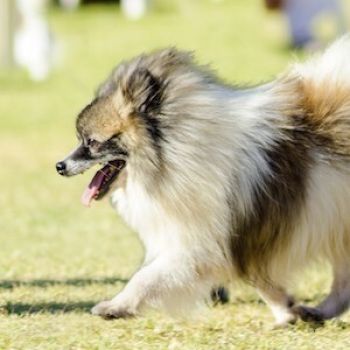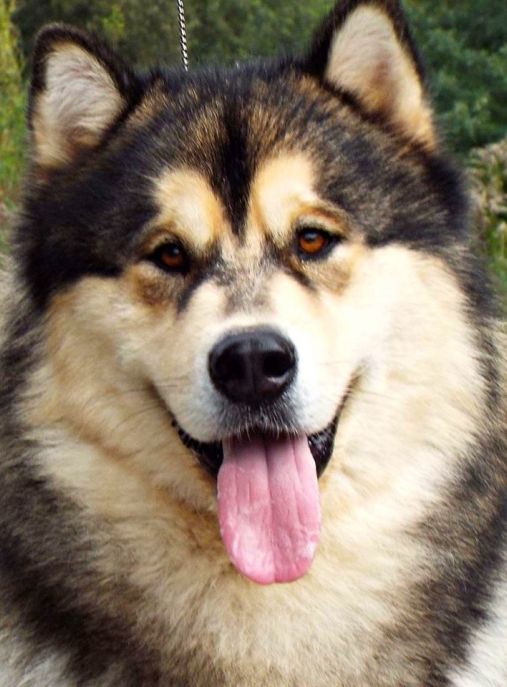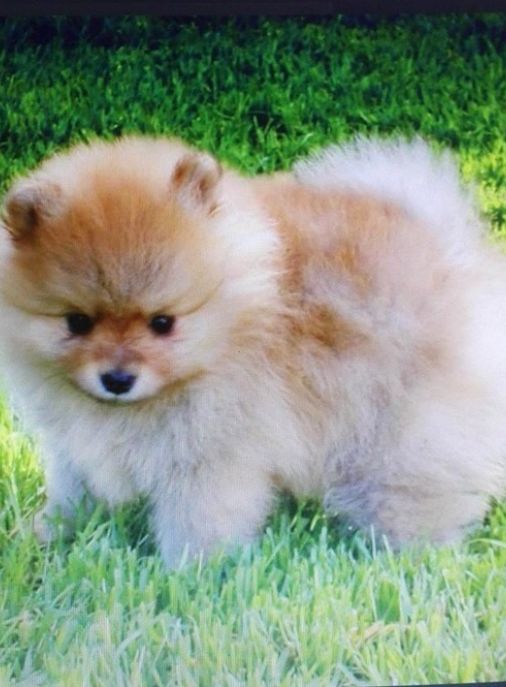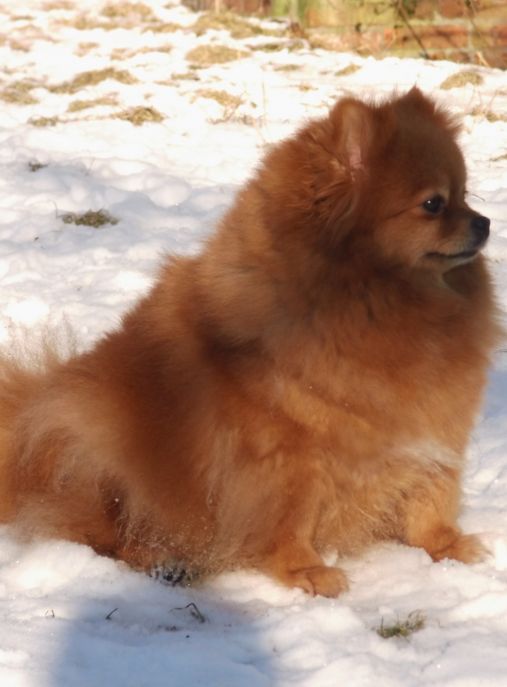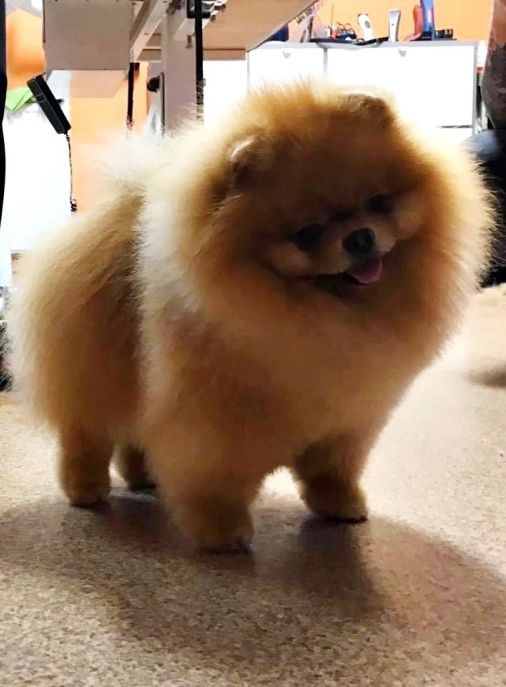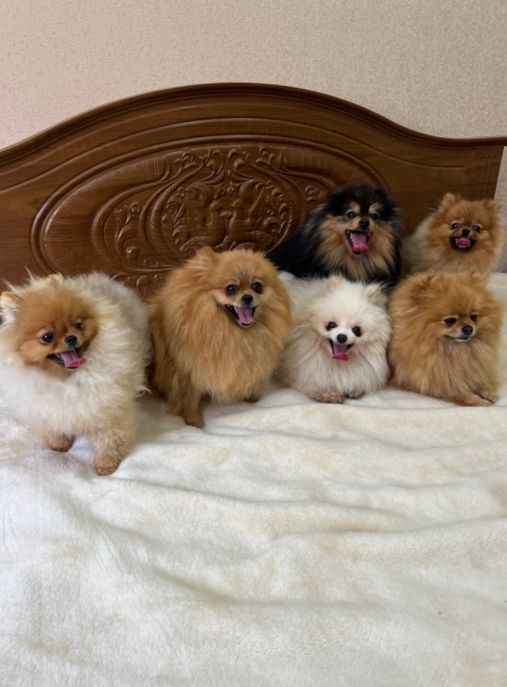The Miniature Spitz Orange, Gray, Other, also known as the German Spitz, is a small and charming dog breed that is beloved for its fluffy coat and lively personality. This breed is a member of the Spitz family, which includes various other breeds such as the Pomeranian, Samoyed, and Keeshond. With its distinctive appearance and friendly nature, the Miniature Spitz Orange, Gray, Other has become a popular choice for dog lovers around the world.
The history of the Miniature Spitz Orange, Gray, Other can be traced back to ancient times. It is believed that the breed originated in Germany, where it was used as a versatile working dog. These dogs were highly valued for their ability to herd livestock, guard homes, and even pull small carts. Over time, they also became popular as companion animals due to their affectionate and loyal nature.
According to the FCI (Fédération Cynologique Internationale) typology, the Miniature Spitz Orange, Gray, Other belongs to Group 5 - Spitz and Primitive Types. This group includes various Spitz breeds that share common characteristics such as a thick double coat, erect ears, and a curled tail carried over the back. The Miniature Spitz Orange, Gray, Other is classified as a companion dog within this group.
These dogs are well-suited for individuals or families looking for a loving and devoted companion. They thrive on human interaction and enjoy being a part of their owner's daily activities. The Miniature Spitz Orange, Gray, Other is known for its playful and energetic nature, making it an excellent choice for families with children or active individuals who can provide them with regular exercise and mental stimulation.
In terms of physical characteristics, the Miniature Spitz Orange, Gray, Other is a small breed with a compact and sturdy build. They typically weigh between 7 to 11 pounds (3 to 5 kilograms) and stand at a height of around 9 to 11 inches (23 to 28 centimeters) at the shoulder. Despite their small size, these dogs possess a confident and lively demeanor.
One of the most striking features of the Miniature Spitz Orange, Gray, Other is its dense and fluffy double coat. The outer coat is long and straight, while the undercoat is soft and thick. This coat requires regular grooming to prevent matting and keep it looking its best. The breed comes in various colors, including orange, gray, and other shades, hence its name.
The life expectancy of the Miniature Spitz Orange, Gray, Other is typically between 12 to 16 years, which is relatively long for a small breed. With proper care, a healthy diet, regular exercise, and routine veterinary check-ups, these dogs can live a happy and fulfilling life.
In addition to their charming appearance and friendly nature, the Miniature Spitz Orange, Gray, Other has several interesting facts associated with the breed. They are known for their intelligence and can be easily trained with positive reinforcement methods. These dogs are also alert and make excellent watchdogs, as they are quick to bark and alert their owners of any potential threats.
Furthermore, the Miniature Spitz Orange, Gray, Other is a highly adaptable breed that can thrive in various living situations. Whether it's a small apartment or a spacious house with a yard, as long as they receive sufficient exercise and mental stimulation, they can adapt well to their environment.
In conclusion, the Miniature Spitz Orange, Gray, Other is a delightful and affectionate breed that brings joy and companionship to its owners. With its fluffy coat, lively personality, and adaptability, it is no wonder that this breed has gained popularity worldwide. Whether as a working dog or a loving companion, the Miniature Spitz Orange, Gray, Other continues to capture the hearts of dog enthusiasts everywhere.

The Miniature Spitz, also known as the German Spitz, is a small and lively breed of dog that comes in various colors, including orange, gray, and other shades. These dogs are known for their charming appearance, intelligence, and playful nature. In this text, we will explore the character of Miniature Spitz dogs, their behavior, and how to raise and train them.
Miniature Spitz dogs are highly intelligent and alert. They are quick learners and have a natural curiosity, making them easily trainable. However, they can also be independent and stubborn at times, so consistent and patient training methods are essential. Positive reinforcement techniques, such as treats and praise, work best with these dogs as they respond well to rewards.
One of the most distinctive traits of Miniature Spitz dogs is their lively and energetic nature. They are always ready for playtime and enjoy engaging in various activities. Regular exercise is crucial for these dogs to keep them physically and mentally stimulated. Daily walks, interactive play sessions, and access to a secure outdoor area are necessary to prevent boredom and destructive behavior.
Despite their small size, Miniature Spitz dogs have a big personality. They are known to be confident, alert, and protective of their families. They make excellent watchdogs and will bark to alert their owners of any potential threats. However, this can also lead to excessive barking if not properly managed. Early socialization is essential to ensure they are comfortable around strangers and other animals.
Miniature Spitz dogs are generally friendly and affectionate towards their families. They form strong bonds with their owners and thrive on human companionship. They enjoy being involved in family activities and are known to be good with children. However, due to their small size, they may not be suitable for households with very young children who may accidentally hurt them.
Grooming is an important aspect of caring for a Miniature Spitz dog. Their thick double coat requires regular brushing to prevent matting and to keep it looking its best. They shed moderately throughout the year, with heavier shedding occurring during seasonal changes. Additionally, regular dental care, nail trimming, and ear cleaning are necessary to maintain their overall health and hygiene.
When it comes to living arrangements, Miniature Spitz dogs can adapt well to both apartments and houses. However, they are not well-suited for outdoor living and prefer to be indoors with their families. They are sensitive to extreme temperatures, so it is important to provide them with a comfortable and climate-controlled environment.
In conclusion, Miniature Spitz dogs are intelligent, lively, and affectionate companions. They require consistent training, regular exercise, and socialization to thrive. With proper care and attention, these dogs can bring immense joy and happiness to their owners' lives.
The Miniature Spitz, also known as the German Spitz, is a small and lively breed that comes in various colors, including orange and gray. These dogs are known for their fluffy double coats, fox-like faces, and friendly personalities. To ensure the well-being of your Miniature Spitz, it is important to provide them with proper care. Here are some tips on how to care for dogs of this breed, including what to do and what not to do:
1. Grooming:
- Do brush your Miniature Spitz's coat regularly to prevent matting and keep it looking its best. Use a slicker brush or a comb with wide teeth to remove loose hair and tangles.
- Do invest in a good quality de-shedding tool to manage the shedding, especially during the seasonal coat blowouts.
- Do check and clean their ears regularly to prevent infections. Use a vet-recommended ear cleaner and gently wipe the outer ear with a cotton ball.
- Do trim their nails regularly to prevent overgrowth. Use a dog nail clipper or grinder and be cautious not to cut into the quick.
- Don't shave your Miniature Spitz's coat, as it provides insulation from both heat and cold. Trimming is acceptable, but the coat should never be completely removed.
2. Exercise:
- Do provide regular exercise to keep your Miniature Spitz physically and mentally stimulated. Daily walks, playtime, and interactive toys are essential.
- Do consider engaging in activities like agility or obedience training, as these dogs are intelligent and enjoy learning new things.
- Do be cautious of extreme temperatures, as Miniature Spitz dogs can be sensitive to heat and cold. Adjust exercise routines accordingly.
3. Nutrition:
- Do feed your Miniature Spitz a high-quality, balanced diet that meets their specific nutritional needs. Consult with your veterinarian to determine the appropriate portion sizes and feeding schedule.
- Do provide fresh water at all times and ensure the bowl is clean.
- Don't overfeed your Miniature Spitz, as they can be prone to weight gain. Obesity can lead to various health issues, so monitor their weight and adjust their diet accordingly.
4. Health:
- Do schedule regular veterinary check-ups to monitor your Miniature Spitz's overall health and address any concerns promptly.
- Do keep up with vaccinations, parasite prevention, and dental care as recommended by your veterinarian.
- Don't ignore any signs of illness or discomfort. Miniature Spitz dogs can be prone to dental problems, so regular dental care is crucial.
5. Socialization and Training:
- Do socialize your Miniature Spitz from an early age to ensure they are well-adjusted and comfortable around people, other animals, and different environments.
- Do provide positive reinforcement-based training to establish good behavior and prevent any potential behavioral issues.
- Don't use harsh training methods or punishment, as these dogs respond best to positive reinforcement and gentle guidance.
Remember, Miniature Spitz dogs thrive on love, attention, and companionship. They are loyal and devoted pets that require consistent care and affection. By following these tips and providing a nurturing environment, you can ensure a happy and healthy life for your Miniature Spitz.
The Miniature Spitz, also known as the German Spitz, is a delightful breed of dog that comes in a variety of colors. Among the most common colors seen in these dogs are orange, gray, and other shades. Let's delve into a detailed description of each of these colors to better understand the beauty of Miniature Spitz dogs.
Orange is a vibrant and eye-catching color that is often associated with the Miniature Spitz breed. The orange coat of these dogs can vary in shade, ranging from a light, almost apricot hue to a deep, rich orange reminiscent of a sunset. The fur is typically dense and fluffy, giving the dog a plush appearance. The orange color is usually evenly distributed throughout the body, with no distinct patterns or markings. It exudes warmth and radiance, making these dogs stand out in a crowd.
Gray is another common color found in Miniature Spitz dogs. The gray coat can have various shades, ranging from a light silver-gray to a darker charcoal gray. The fur is typically thick and double-coated, providing insulation and protection from the elements. The gray coloration is often uniform throughout the body, giving the dog a sleek and elegant appearance. Some Miniature Spitz dogs may have a slight variation in shade, with lighter gray on the underbelly and darker gray on the back and sides. This color adds a touch of sophistication to the breed.
Apart from orange and gray, Miniature Spitz dogs can also come in other colors. These "other" colors encompass a wide range of possibilities, including but not limited to white, black, cream, sable, and parti-colors. White Miniature Spitz dogs have a pristine and pure appearance, with their fur being completely devoid of any pigmentation. Black Miniature Spitz dogs, on the other hand, have a striking and bold appearance, with their fur being a deep, solid black. Cream-colored Miniature Spitz dogs have a soft and delicate appearance, with their fur being a pale, creamy shade. Sable Miniature Spitz dogs have a unique and captivating appearance, with their fur displaying a mix of colors, often resembling a wolf-like pattern. Lastly, parti-color Miniature Spitz dogs have a playful and charming appearance, with their fur being a combination of two or more distinct colors, such as black and white or orange and white.
In conclusion, the Miniature Spitz breed is known for its diverse and captivating color palette. Whether it be the vibrant orange, the sleek gray, or the myriad of other colors, each Miniature Spitz dog possesses a unique and beautiful coat that adds to their overall charm and appeal.
Miniature Spitz, also known as German Spitz, are small and lively dogs with a distinctive fox-like appearance. They come in various colors, including orange, gray, and other shades. These dogs are generally healthy, but like any breed, they can be prone to certain health conditions. To ensure the well-being of Miniature Spitz dogs, it is essential to provide proper care and be aware of common health issues.
One of the most common health concerns in Miniature Spitz dogs is dental problems. Their small mouths can lead to overcrowding, which increases the risk of dental diseases such as periodontal disease and tooth decay. Regular dental care, including brushing their teeth and providing appropriate chew toys, can help maintain good oral health.
Another health issue that Miniature Spitz dogs may face is patellar luxation. This condition occurs when the kneecap slips out of place, causing discomfort and lameness. Regular exercise and maintaining a healthy weight can help prevent this condition. If patellar luxation is suspected, a veterinarian should be consulted for proper diagnosis and treatment.
Miniature Spitz dogs are also prone to allergies, which can manifest as skin irritations, itching, and hair loss. Allergies can be triggered by various factors, including food, environmental allergens, or parasites. Identifying and avoiding the allergen, along with regular grooming and maintaining a clean living environment, can help manage allergies in these dogs.
Another health concern in Miniature Spitz dogs is progressive retinal atrophy (PRA). PRA is a genetic condition that causes progressive vision loss and can eventually lead to blindness. Responsible breeders perform genetic testing to ensure that their breeding dogs are free from this condition. Regular eye examinations by a veterinarian can help detect PRA in its early stages, allowing for appropriate management and care.
To maintain the overall health of Miniature Spitz dogs, a balanced diet is crucial. Feeding them high-quality dog food that meets their nutritional needs is essential. Overfeeding should be avoided to prevent obesity, which can lead to various health issues, including joint problems and heart disease.
Regular exercise is also important for Miniature Spitz dogs. Despite their small size, they have high energy levels and require daily physical activity to stay mentally and physically stimulated. Daily walks, playtime, and interactive toys can help meet their exercise needs.
Routine veterinary check-ups are vital for the health of Miniature Spitz dogs. Regular vaccinations, parasite prevention, and early detection of any health issues are essential for their well-being. Additionally, grooming should not be overlooked, as regular brushing, nail trimming, and ear cleaning can help maintain their coat and prevent infections.
In conclusion, Miniature Spitz dogs are generally healthy, but they can be prone to dental problems, patellar luxation, allergies, and progressive retinal atrophy. Providing proper dental care, regular exercise, a balanced diet, and routine veterinary check-ups are essential for their overall health. Responsible breeding practices and genetic testing can help reduce the risk of hereditary conditions. With proper care and attention, Miniature Spitz dogs can lead happy and healthy lives.
The Miniature Spitz, also known as the German Spitz, is a small and lively breed of dog that comes in various colors, including orange and gray. These adorable dogs require a well-balanced and nutritious diet to maintain their overall health and vitality. In this text, we will explore the nutritional needs of Miniature Spitz dogs and provide advice on how to feed them appropriately.
To ensure optimal health, it is essential to provide a balanced diet that includes all the necessary nutrients. A high-quality commercial dog food specifically formulated for small breeds is a good option for Miniature Spitz dogs. Look for a product that lists meat as the primary ingredient, as it provides essential proteins for muscle development and maintenance.
When selecting dog food, it is crucial to consider the age, weight, and activity level of your Miniature Spitz. Puppies have different nutritional requirements than adult dogs, so choose a food that is appropriate for their age. Additionally, if your dog is more active or has a higher metabolism, they may require a diet with higher protein and fat content.
In addition to commercial dog food, you can also include some fresh and natural foods in your Miniature Spitz's diet. Lean meats such as chicken, turkey, or beef can be cooked and added to their meals. These meats provide additional protein and essential amino acids. However, it is important to remove any bones, skin, or excess fat before feeding them to your dog.
Fruits and vegetables can also be beneficial for your Miniature Spitz's overall health. Apples, carrots, blueberries, and green beans are excellent choices as they provide essential vitamins, minerals, and fiber. However, avoid feeding your dog grapes, raisins, onions, garlic, or any other foods that are toxic to dogs.
While treats can be a great way to reward your Miniature Spitz, it is important not to overdo it. Excessive treats can lead to weight gain and nutritional imbalances. Choose healthy and low-calorie treats specifically designed for small dogs, and limit the quantity to avoid overfeeding.
It is crucial to provide fresh and clean water at all times to keep your Miniature Spitz hydrated. Ensure that the water bowl is easily accessible and regularly cleaned to prevent any bacterial growth.
Avoid feeding your Miniature Spitz table scraps or human food, as it can lead to digestive issues and obesity. Some human foods, such as chocolate, caffeine, alcohol, and certain spices, are toxic to dogs and should be strictly avoided.
Lastly, it is essential to monitor your Miniature Spitz's weight and body condition regularly. Obesity can lead to various health problems, so if you notice your dog gaining weight, consult with a veterinarian to adjust their diet accordingly.
In conclusion, a well-balanced and nutritious diet is crucial for the overall health and well-being of Miniature Spitz dogs. Providing them with high-quality commercial dog food, supplemented with lean meats, fruits, and vegetables, will ensure they receive all the necessary nutrients. Avoid feeding them toxic foods, excessive treats, and table scraps. By following these guidelines and monitoring their weight, you can help your Miniature Spitz live a long and healthy life.


